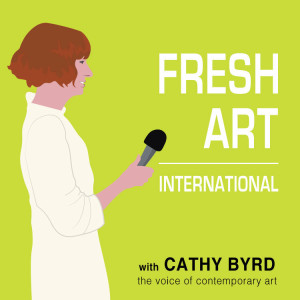Writer/curator Cathy Byrd sparks conversations about today’s art, design, and film on the Fresh Art International podcast. Synthesizing interviews and field recordings with critical commentary since 2011, the podcast archives the voices, sounds, and stories of contemporary culture makers from around the world.
Episodes

Tuesday Feb 04, 2020
Edra Soto on the Architecture of Connecting with Communities
Tuesday Feb 04, 2020
Tuesday Feb 04, 2020
Edra Soto is a Puerto Rico born, Chicago based, interdisciplinary artist, educator and curator whose architectural projects connect with communities. Soto's temporary modular SCREENHOUSE pavilions are evocative symbols of her cultural assimilation that we can enter and share. Each free-standing structure functions as both sculptural object and social gathering place. Couched in beauty, her ongoing OPEN 24 HOURS project offers a different visceral encounter — with evidence of displacement and want. The aesthetic display of cast-off liquor bottles culled from steadily accumulating detritus in the historically Black neighborhood she now calls home suggests that we consider the personal and communal impact of poverty and racism. During a studio visit with the artist in Northwest Chicago, we talk about recent iterations of these projects.
In concert with the 2019 Chicago Architecture Biennial, the Millennium Park Foundation commissioned the artist to produce a temporary gathering place in one of the park’s outdoor galleries. Only steps from Anish Kapoor’s Cloud Gate, she worked with a team to construct SCREENHOUSE. The 10-foot high pavilion made of 400 charcoal-hued, 12-inch cast concrete blocks is part of an ongoing project, an architectural series inspired by iron grills and decorative concrete screen blocks found throughout the Caribbean and the American South.
New versions of OPEN 24 HOURS are on view in two 2020 exhibitions. One appears in Open House: Domestic Thresholds at the Albright-Knox Museum, in Buffalo, New York. Cognac bottles carefully arranged on shelves with decorative panels reveal the artist’s connection to two places she calls home. More liquor bottles command attention in the three-part installation she designed for State of the Art 2020. Featuring work by artists from across the United States, the exhibition celebrates the opening of The Momentary, a new contemporary art space at the Crystal Bridges Museum, in Bentonville, Arkansas.
Sound Editor: Anamnesis Audio
Related Episodes and Photo Features: Architecture with a Sense of Place, Views—Chicago Architecture Biennial 2019, Fresh VUE: Chicago Art and Architecture 2017
Related Links: Edra Soto, The Momentary, State of the Art 2020, Crystal Bridges Museum of Art, Knox-Albright Museum, Millennium Park, Chicago Architecture Biennial 2019
About Edra Soto: Born in Puerto Rico and based in Chicago, Edra Soto is an interdisciplinary artist, educator, curator, and co-director of the outdoor project space THE FRANKLIN. She is invested in creating and providing visual and educational models propelled by empathy and generosity. Her recent projects, which are motivated by civic and social actions, focus on fostering relationships with a wide range of communities.
Recent venues presenting Soto’s work include Chicago Cultural Center (IL), Nerman Museum of Contemporary Art (KS), Pérez Art Museum Miami (FL), Museo de Arte de Puerto Rico (PR), Hunter EastHarlem Gallery (NY), UIC Gallery 400 (IL), Smart Museum (IL), Bemis Center for Contemporary Art (NE), DePaul Art Museum, and the Museum of Contemporary Art of Chicago (IL). Soto was awarded the Efroymson Contemporary Arts Fellowship, the DCASE for Individual Artist Grant from the City of Chicago, the 3Arts Make A Wave award, and 3Arts Projects grants, and the Illinois Arts Council grant.
Soto holds an MFA from The School of the Art Institute of Chicago, and a Bachelor of Arts from Escuela de Artes Plásticas de Puerto Rico. She teaches Introduction to Social Engagement at University of Illinois in Chicago and is a lecturer at the School of the Art Institute of Chicago.
About SCREENHOUSE: Decorative screens, known as rejas and quiebrasoles, are ubiquitous in Soto’s birthplace in Puerto Rico. In her SCREENHOUSE series, Soto transforms the quiebrasol form from a planar screen that divides public from private into a nearly fully enclosed, free-standing structure that functions as both sculptural object and social gathering place.
About OPEN 24 HOURS: Witnessing the excessive accumulation of litter and detritus in the historic African American neighborhood of East Garfield Park where she lives motivated Edra Soto to initiate this ongoing project. Since December 2016, Soto has been collecting, cleaning and classifying cast-off liquor bottles to create installations that display the impact of racism and poverty on this marginalized community in Chicago. Bourbon Empire, the book quoted below, recounts the historic connection between African Americans and cognac from its genesis in the 1930s to contemporary repercussions instigated by hip-hop and rap culture.
“Cognac’s relationship with African American consumers started later, when black soldiers stationed in southwest France were introduced to it during both world wars. The connection between cognac producers and black consumers was likely bolstered by the arrival of black artists and musicians... France appreciated these distinctive art forms before the U.S. did, continuing a French tradition dating back to Alexis de Tocqueville of understanding aspects of American culture better than Americans did. For African Americans, the elegant cognac of a country that celebrated their culture instead of marginalizing it must have tasted sweet ... During the 1990s, cognac sales were slow, and the industry was battling an image populated by fusty geriatrics. Then references to cognac began surfacing in rap lyrics, a phenomenon that peaked in 2001 with Busta Rhymes and P. Diddy’s hit “Pass the Courvoisier,” causing sales of the brand to jump 30 percent. During the next five years, other rappers teamed up with brands, and increased overall sales of cognac in the U.S. by a similar percentage, according to the Distilled Spirits Council of the United States.”
—Reid Mitenbuler, author of Bourbon Empire: The Past and Future of America’s Whiskey

No comments yet. Be the first to say something!